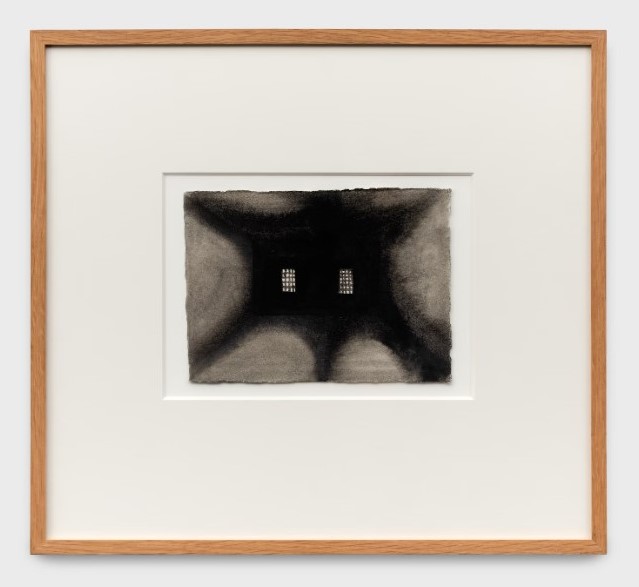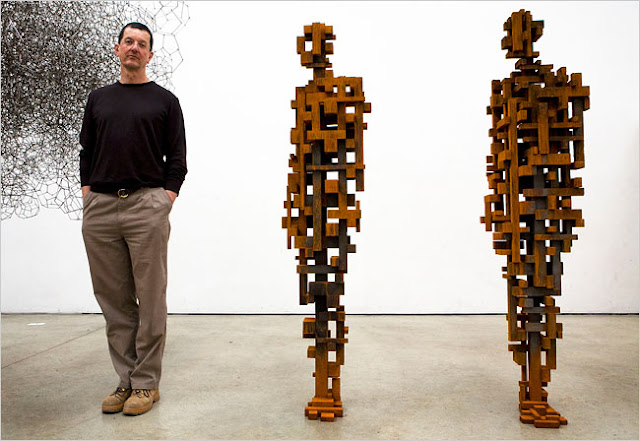ANTONY GORMLEY BODY FIELD AT XAVIER HUFKENS
ANTONY GORMLEY BODY FIELD
AT XAVIER HUFKENS
October 28, 2022 - December 17, 2022
Antony
Gormley asks how can still, silent objects cause us to move and be moved. In
BODY FIELD, Gormley invites us to bring our own physical presence into a field
of “sculpture as an instrument for awareness”.
Immediately upon entering the gallery, the
artist’s proposition is clear: the open end of a 155-meter-long steel tube lies
on the floor in dialogue with a dark opening in a concrete bunker. Behind it, a
drawing evokes the cosmic darkness of a black hole. Taken together, these three
works acknowledge the body as a place, materialise its inner tensions, and
affirm its need for shelter.
The
sculptural installation RUN III (2022) is both activating and activated: it
transforms the architectural space but, at the same time, is animated by human
interaction. The sculpture is a line that weaves through the gallery with
horizontals at the domestic heights of chairs and tables, windowsills and
ceilings, so that our familiarity with its geometry is both triggered and
confused. By re-presenting our built world, RUN III allows us to walk through
walls whilst becoming aware of how architecture encourages and enforces
particular forms of bodily choreography.
CORNER (2022)
—what the artist has called a concrete “bunker for one” —is the first of two
works that bookend the exhibition. Like its companion piece on the gallery’s
third floor, the sculpture was created from digital scans of Gormley’s body as
he crouched isolated in space or was compressed into a corner, identifying a
human space in space at large. A single square opening —almost equivalent to
the size of the steel tube of RUN III —is the solitary clue that these
structures are hollow. Like compact dwellings, these works allude to the body
as a house, acknowledging its dual nature as a space of refuge and
imprisonment. This is a place where the body can be bound but the mind set
free.
Corresponding
visually to the linear language of RUN III and in an extra[1]ordinary feat of
casting, a group of Knotwork sculptures take the notion of three-dimensional
mapping from building to body. Whereas RUN III allows us to calibrate our
physical relationship to the architectural receptacle of a building or room,
the tighter, denser pathways of these works chart the interior of the human
body. These “maps of the interior” show evidence of internal pressure and
tension in the brain, heart, stomach and knees, capturing moments of lived time
within the body.
Throughout
the exhibition, carefully placed drawings provide interpretational clues to the
sculptures. They invite us to connect our proprioceptive intuition about the
inner places of the body with the infinite darkness of an expanding universe or
the plotted points of an oil field.
In a radical
departure from Gormley’s normal practice of isolating a single body in space,
the new Double Blockworks in the gallery’s lower level evoke mitosis, or the
division and replication of cells that guarantees the continuance of life. In
making this series, Gormley reflected upon Michelangelo’s final unfinished
sculpture —the Rondanini Pietà (1552-64) —as a metaphor for the relationship
between the sculptor and his material, life and death. Many of the Double
Blockworks are based on scans of the artist clasping a previously made
blockwork: an acknowledgement of his relationship with the art of sculpture.
For the artist, the doubled figures embody “matter as a continual dance of
possibility between emergence and entropy, the acknowledgement of instability
and inevitable jeopardy, but, at the same time, connection, the need to stand
and to hold —to touch the world, the future, another body.”
The most
extensive exhibition of Gormley’s work in Germany to date is currently on view
at the Lehmbruck Museum in September 2022 in dialogue with the work of Wilhelm
Lehmbruck. Recent solo exhibitions include Museum Voorlinden, Wassenaar (2022);
Schauwerk Sindelfingen, Sindelfingen, (2021); National Gallery Singapore
(2021); Royal Academy, London (2019); Island of Delos, Greece (2019); Busan
Museum of Art (2019); Uffizi Gallery, Florence (2019); the Philadelphia Museum
of Art (2019); Kettle’s Yard, Cambridge (2018); Long Museum, Shanghai (2017);
The National Portrait Gallery, London (2016). He has participated in the Venice
Biennale (1982 and 1986) and Documenta 8 (1987). Permanent public works include
Angel of the North (Gateshead, England), Another Place (Crosby Beach, England),
Inside Australia (Lake Ballard, Western Australia) and Exposure (Lelystad, The
Netherlands).
https://www.xavierhufkens.com/exhibitions/body-field
BRIDGE, 2021
Cast Iron
Dimensions: 176.8 x 79.3 x 47.2 cm, 69 5/8 x 31 1/4 x 18 5/8 in
© Antony Gormley
TIE, 2021
Cast Iron
Dimensions: 188.8 x 61.4 x 41.4 cm, 74 3/8 x 24 1/8 x 16 1/4 in
© Antony Gormley
MOOR, 2021
Cast Iron
Dimensions: 35 x 199 x 90 cm, 13 3/4 x 78 3/8 x 35 3/8 in
© Antony Gormley
SIDLE, 2021
Cast Iron
Dimensions: 178.1 x 42.6 x 58 cm, 70 1/8 x 16 3/4 x 22 7/8 in.
© Antony Gormley
SHELTER, 2021
Cast Iron
Dimensions: 166.9 x 71.4 x 56.3 cm, 65 3/4 x 28 1/8 x 22 1/8 in
© Antony
Gormley
CORNER, 2022
Concrete
Dimensions: 90 x 67.7 x 80.7 cm, 35 3/8 x 26 5/8 x 31 3/4 in.
© Antony
Gormley
FUSE XIX, 2015
Carbon and Casein on Paper
Dimensions: 28 x 38.2 cm, 11 x 15 in.
© Antony
Gormley
OBJECT IV, 2018
Carbon and Casein on Paper
Dimensions: 27.8 x 38.5 cm, 11 x 15 1/8 in
© Antony
Gormley
RETREAT, 2022
Concrete
Dimensions: 92.5 x 58.8 x 76 cm, 36 3/8 x 23 1/8 x 29 7/8 in
© Antony
Gormley
HATCH I, 2006
Carbon and Casein on Paper
Dimensions: 56.5 x 75 cm, 22 1/4 x 29 1/2 in.
© Antony
Gormley
RUN III, 2022
Mild Steel Square Tube 40 x 40 mm
Dimensions Variable
© Antony
Gormley
RELIEF (FRAME), 2021
Cast Iron
Dimensions: 43.3 x 199.5 x 46.5 cm, 17 1/8 x 78 1/2 x 18 1/4 in.
© Antony
Gormley
FRAME III, 2020
Cast Iron
Dimensions: 47 x 68 x 105 cm, 18 1/2 x 26 3/4 x 41 3/8 in.
© Antony
Gormley
FALL IV, 2022
18 mm Square Section Mild Steel Bar
Dimensions: 492 x 116 x 98.5 cm, 193 3/4 x 45 5/8 x 38 3/4 in
© Antony
Gormley
BIND, 2020
Cast Iron
Dimensions: 184.3 x 65.2 x 49.6 cm, 72 1/2 x 25 5/8 x 19 1/2 in
© Antony
Gormley
RETREAT (FRAME), 2021
Cast Iron
Dimensions: 80 x 49 x 68.6 cm, 31 1/2 x 19 1/4 x 27 1/8 in.
© Antony
Gormley
STACK, 2021
Cast Iron
Dimensions: 173.8 x 61.6 x 77.3 cm, 68 3/8 x 24 1/4 x 30 3/8 in.
© Antony
Gormley
COAGULATE IV, 2016
Crude Oil on Paper
Dimensions: 111.7 x 76.1 cm, 44 x 30 in
© Antony
Gormley
SLUICE, 2018
Cast Iron
Dimensions: 68.2 x 180.1 x 46 cm, 26 7/8 x 70 7/8 x 18 1/8 in
© Antony
Gormley
SEE VII, 2018
Carbon and Casein on Paper
Dimensions: 38.3 x 27.8 cm, 15 1/8 x 11 in
© Antony
Gormley
START I, 2018
Carbon and Casein on Paper
Dimensions: 38 x 28 cm, 15 x 11 in
© Antony
Gormley
SEE I, 2018
Carbon and Casein on Paper
Dimensions: 38.2 x 27.8 cm, 15 x 11 in
© Antony
Gormley
OPEN WRENCH, 2014
4 mm Corten Steel
Dimensions: 175 x 45.5 x 40.4 cm, 68 7/8 x 17 7/8 x 15 7/8 in
© Antony
Gormley
VIEW, 1993
Carbon and Casein on Paper
Dimensions: 14 x 19 cm, 5 1/2 x 7 1/2 in
© Antony
Gormley
PLASMA PLEROMA II,
2018
Carbon and Casein on Paper
Dimensions: 28 x 37.7 cm, 11 x 14 7/8 in
© Antony
Gormley
SETTLE, 2022
Cast Iron
Dimensions: 84.3 x 63.5 x 96.5 cm, 33 1/4 x 25 x 38 in
© Antony
Gormley
SQUIDGE, 2022
Cast Iron
Dimensions: 67.1 x 51.5 x 67 cm, 26 3/8 x 20 1/4 x 26 3/8 in
© Antony
Gormley
EARTH, 2021
Cast Iron
Dimensions: 25.2 x 202.5 x 54.7 cm, 9 7/8 x 79 3/4 x 21 1/2 in
© Antony
Gormley
SKEW, 2022
Cast Iron
Dimensions: 178.6 x 51 x 32.2 cm, 70 1/4 x 20 1/8 x 12 5/8 in
© Antony
Gormley
DANDLE, 2022
Cast Iron
Dimensions: 161 x 60.1 x 58.2 cm, 63 3/8 x 23 5/8 x 22 7/8 in
© Antony
Gormley











































,%202021.jpg)






%202021.jpg)






























